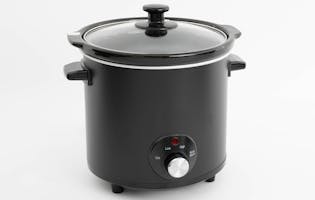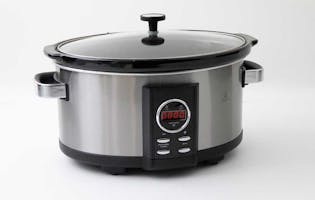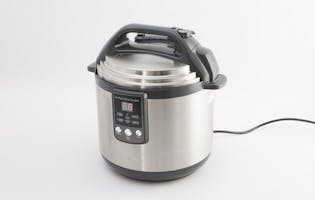What's the best way to reheat your leftovers?

Putting food on the table is the most widespread concern among New Zealanders, according to our latest Sentiment Tracker results. Sixty-eight percent of consumers consider the cost of food and groceries to be one of their biggest financial concerns.
Despite this, we’re a land of food wasters. The average Kiwi family throws away around three shopping trolleys worth of edible food each year. That’s around $1,520 wasted. But by using your kitchen appliances wisely, you can makeover your leftovers. We share our tips below.
Microwave

Quick and easy, the microwave is often the first port of call when reheating leftovers. Many models will have a reheat function which calculates the reheating time based on the weight and type of food (although we expect many people don’t use it).
If you don’t reheat properly, your leftovers will be worse for wear – you won’t see many hands up for dry and tasteless pasta or rice. Reheating a solid food, like quiche or lasagne, is also tricky because you can’t stir it. For crispy foods, like pizza or hot chips, the microwave isn’t the best reheating option because you’ll wind up with soggy seconds.
Tips for microwave reheating
- Use the correct power level. The power level controls how often the heating comes on during cooking and lets you control the heating intensity. For example, power level 6 may mean heating is on for 60% of the time. The fan runs the whole time to circulate air, while the heating turns on and off to achieve optimum cooking. Most manufacturers recommend using 60-70% of the power for reheating.
- Use the right container. Reheat leftovers in a microwave-safe container and never use takeaway containers. Reheating foods with a higher fat content can cause plastic containers to melt or distort, leaching plastics into your food.
- Cover your food. This helps hold moisture, evens heat distribution, and prevents hard-to-clean splatters all over the microwave. A damp paper towel or microwave plate cover will do the trick.
- Add moisture. If you’re reheating something that’s usually cooked in water, like pasta or rice, add extra water so it doesn’t dry out. Either cover with a damp paper towel or add a few tablespoons of water and cover. The extra water will create steam and give new life to your dish.
- Portion control. If you’re heating a large piece of food, cut it into smaller pieces (up to two servings) so it doesn’t overcook on the outside by the time it’s heated through. Place a knife in the centre of the food to check the temperature.
- Stir it. Foods that can be stirred should be stirred part way through reheating to ensure there are no cold spots.
- Let it stand. This is particularly important for dense foods like quiche or lasagne to ensure they are heated evenly and through to the centre. Foods should stand covered for at least two minutes before serving.
Air fryer

The ubiquitous air fryer is a stellar option for reheating leftovers. Perfect for foods that are best crunchy, such as pizza, chips, fast foods, or practically anything that’s been fried or has a crunchy coating. You can also use it to heat and crisp up cooked veges, reheat steaks, chicken, sausages, pies, the list goes on.
OK, it might take longer than a microwave, but the result will be better for most foods. Another option is to use the microwave for the initial heat, and the air fryer for the final crisping.
If you have foods that need to maintain some moisture, such as baking, burgers, chicken, steaks, or any other food that has dried out in the fridge, you can add a small amount of water to the bottom of the air fryer pan. Be warned, don’t fill your prized possession with lots of water; only add a tablespoon or two into the bottom of the basket, as heating elements and fans are not best friends with liquids. A small amount of water in the bottom can also help reduce smoking when cooking fatty foods.
You can reheat most leftovers in around five minutes in an air fryer, but timings will vary depending on the amount and thickness of the food and the model of air fryer you have. You’ll need to experiment with temperatures too, starting with lower temps (160-180℃) so as not to burn food.
There will be a limit to how much you can reheat in an air fryer at any one time, so unless you have an extra-large air fryer, it may not be the answer for a reheated family meal.
Slow cooker

A slow cooker is perfect for making stock from leftover chicken, beef or lamb bones. Add the bones to your slow cooker with any leftover veges lurking in your fridge (it doesn’t matter if they’re wilted), cover with water and simmer all day. You can use the stock for soup or the base of another meal.
Slow cooker rice pudding is a budget dessert for milk that’s about to go off. Add three cups of milk to approximately ¾ of a cup of white rice, some sugar and spices, then cook on high until the rice has absorbed the liquid.
While you can’t reheat leftovers in a slow cooker, this appliance is also great for cooking double batches of meals so you’ll get leftovers you can eat the next day or freeze.
Frying pan or saucepan

Most leftovers can also be reheated in a frying pan or saucepan.
Tips for reheating on a cooktop
- Use the right size pan or pot for the food you’re reheating. Too big and it may burn, too small and it will take too long to reheat.
- Restore food to its original consistency by adding liquid (water, stock, milk, cream). This stops the leftovers from drying out.
- Stir or flip the food regularly to heat evenly.
- Use a moderate heat. If it’s too high, the outside will cook before the food is heated through.
Making sure leftovers are safe to eat

Follow these food safety tips for keeping leftovers safe to eat.
- Cool leftovers as quickly as possible and refrigerate within two hours of cooking.
- Cover leftovers or store them in a container before putting in the fridge.
- Eat leftovers within two days.
- Make sure leftovers are reheated thoroughly to steaming hot throughout. You should reheat leftovers rapidly to 70℃ and keep them at that temperature for two minutes.
- Don’t reheat leftovers more than once.
- If you freeze leftovers they will last for at least two months. Label the container with a date so you know how old the food is.
Consumer staff share their favourite leftover makeovers

“One of my fave things to do in the air fryer, is take some slices of stale bread and any leftover fillings (roasted meats or cooked veges etc) and make an air fried toastie – you need to add some cheese of course, and the air fryer toasts all the way through the bread and creates an uber crunchy toasted sandwich.”
— Bryan Wall, product test writer

“When I cook roast chicken, I always make sure there’s enough left to cook a second meal. Our family favourites are turning leftover chicken into enchiladas with a can of tomatoes and kidney beans, or combining with leftover and frozen veges, stock and cream, and topping with a sheet of flaky pastry – the best chicken pie ever.”
— Belinda Castles, research and test writer

“I use fish bones to make fish stock after we’ve been out fishing. Also, when I make sourdough I use the discard to make crumpets.”
— Abby Damen, communications and campaigns adviser

“Leftover mince is a favourite for us. If there’s enough left over, I make a cottage pie – otherwise it’s mince on toast for lunch the next day.”
— Kirsty Rennie, content product researcher

“I throw any leftovers in a pan with a few eggs and put grated cheese on top (parmesan is the best), then brown under the grill. Leftover noodles or pasta become a great fritter, and if you use old leftover veges you can call that a frittata. Pizza is also great reheated in a dry frying pan for a few minutes on both sides – yes cheese side down too. You get lovely crispy pizza.”
— Paul Smith, head of testing

“I freeze leftover rice so I have it on hand for a stir fry. It’s also a good recipe standby when I need to use whatever veges are left in the fridge at the end of the week.”
— Rebecca Styles, research team leader
We've tested 24 slow cookers and multi-cookers.
Find the right one for you.



Member comments
Get access to comment